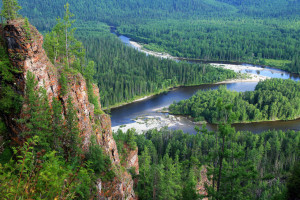“You have no mercy on the woods, or the birds, or on women, or on one another…”
Uncle Vanya, А.P. Chekhov, 1896

Chekhov’s Uncle Vanya and The Cherry Orchard were written more than a century ago, but they remain a brilliant portrait of Russian society and its attitude toward the world around, woods included.
Forests cover around 45 percent of Russia’s territory, and the country accounts for 24 percent of the world’s timber resources. The Siberian taiga and its cedar trees are as much a symbol of Russia as the Kremlin and Sputnik. It would seem that Russian forests should be valued and protected as a national treasure. However, just like the people of Russia, Russian forests have their own peculiar fate full of suffering and tragic mistakes.
Back in 2013, an international team of scientists calculated that from 2000 to 2012, Russia had lost more forest area than any other country in the world. Such forest cover loss was caused by different reasons including forest fires, storms and insect pests. However, this was also due in no small part to human activity. According to World Wildlife Fund’s estimates, Russia annually loses around $1 billion due to illegal logging.
According to First Deputy Prosecutor General Aleksander Buksman, illegal logging is responsible for more than 800,000 hectares of Russia’s forest loss annually, which is more than half of the total wood harvest in the country. The volume of Russian illegal logging has been increasing year after year. Furthermore, legal wood harvesting that is approved by the authorities is not always reasonable and justified. Suffice to recall the case of the Khimki forest, when a forested area located within the Moscow city limits was ruthlessly destroyed to make way for a new toll road to Sheremetyevo airport which, by the way, remains practically deserted since drivers are not willing to pay to use this highway.
After the 2010 wildfires in Central European Russia, that covered Moscow and St. Petersburg with thick smoke for almost a week, the problem of preventing forest fires reached the highest echelons of power. Putin, who was now personally fighting fires, was also the one who had personally abolished the state Forest Service and reduced allocations for fire prevention measures a few years before that.
Today, it can be said with confidence that no conclusions have been drawn from the 2010 events. In 2016, forests wildfires continue their rampage across Russia with the only difference being that while smoke from these fires can still sometimes be felt in Moscow, it hardly ever reaches Putin’s hometown St. Petersburg. It appears that this is the reason why the problem of wildfires is not being discussed at the top government level and figures reflecting the actual state of things do not make it into statutory reports. But even if one trusts official figures, one has to acknowledge that forest regeneration in Russia has dropped to its lowest level in the last decade, Considering the speed at which the country’s forest cover has been decreasing and which, according to Greenpeace Russia, reaches 2.9 million hectares per year, Russia is rapidly turning from a forest country into a prairie one.

Meanwhile, according to a report prepared by the Lesprom Network Analytic Agency, in 2015 the Russian forest sector showed a 300-percent profit growth. Although the ruble devaluation has obviously played a part, a sudden expansion of exports of forest products is the main reason behind this three-fold increase in lumberjacks’ income. Thus, although Russian forest industrialists have good prospects for self-enrichment, the taiga and its cedar trees seem to be doomed like Chekhov’s cherry orchard which, as is well known, was simply cut down.





